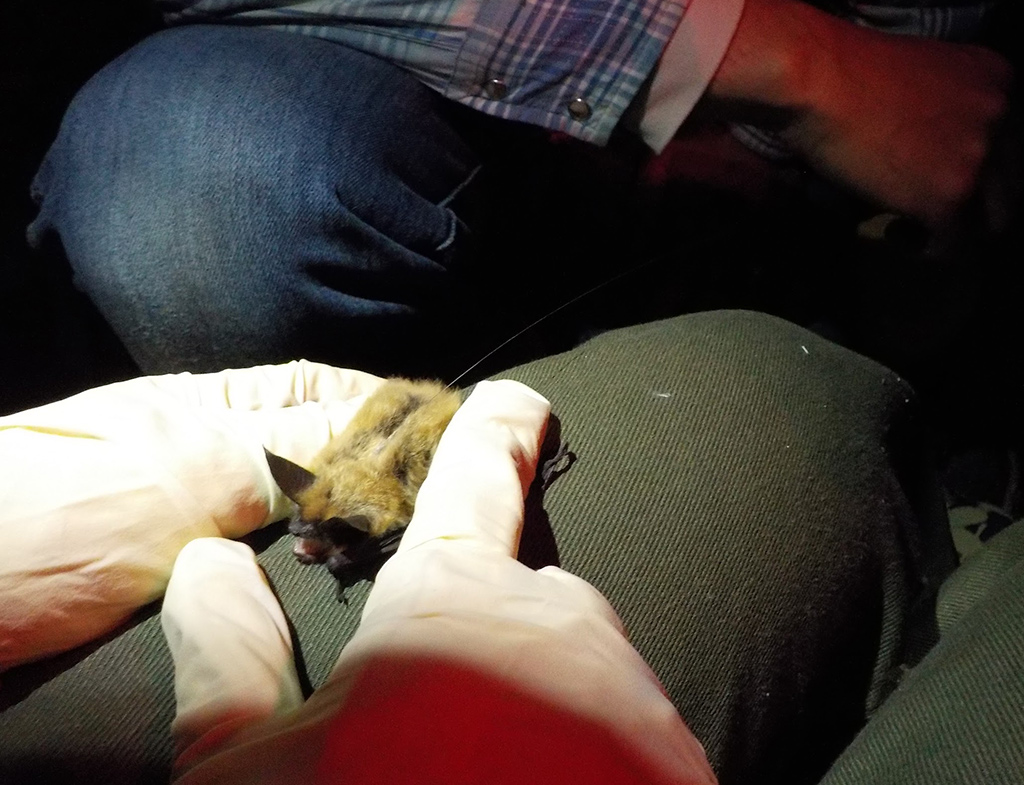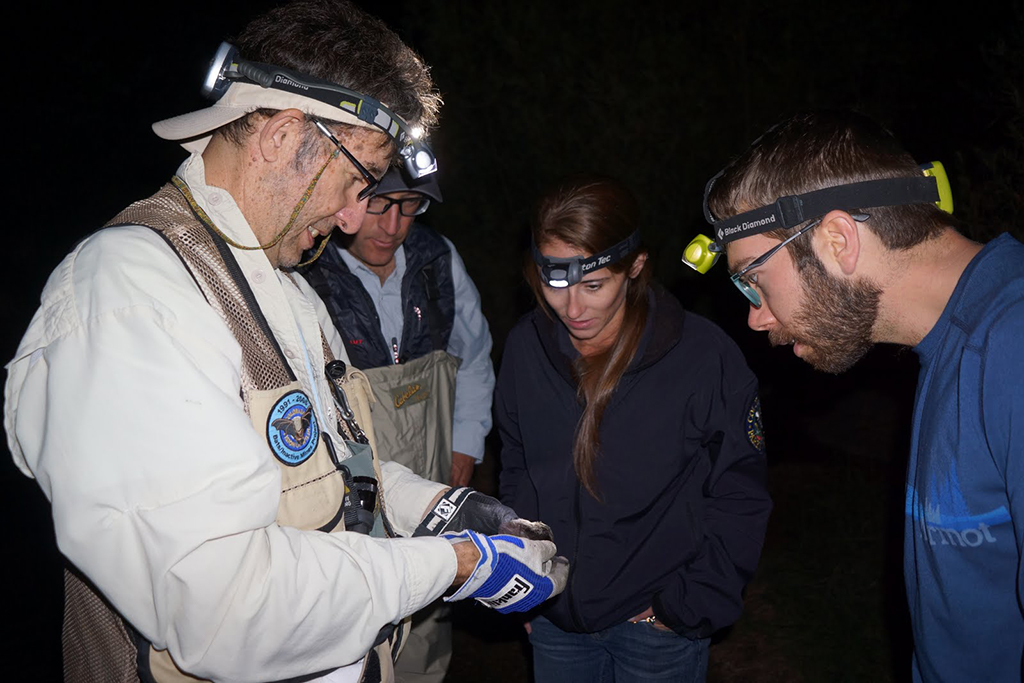It was a typical workday for Philip Knecht. He and his partner Alonzo Mandanna assembled their gear: helmets, harnesses, ropes, rack—and endoscopic cameras, probes and audio equipment. The team of climbing conservationists then set out for an ascent of Devil’s Tower in northeast Wyoming. After building an anchor and lowering themselves above a particularly good-looking crack, Knecht and Mandanna got to work—not logging knuckle-busting sends on the tower’s vertical face, but looking for signs of another species that shares a climber’s affinity for splitter cracks—bats.
Knecht works as a biological science technician at Devil’s Tower National Monument, locating and monitoring the area’s bat population. As a climber, he is able to merge his passion for scaling sheer granite cliffs with his profession as a biologist. While Knecht’s career is a perfect blend of skill sets, many scientists have begun harnessing the particularly vertical enthusiasm of the climbing community to track and monitor bat populations throughout the West.

Climbing biotech Philip Knecht snakes his camera down a crack at Devil’s Tower. (Photo Courtesy: Philip Knecht)
Although many people see bats as scary creatures or even nuisances, they’re vital to the ecosystems that they live in. The Center for Biological Diversity estimates bats contribute roughly $22.9 billion per year to the agriculture industry in insect management. Bats’ hunting abilities help keep insect populations in check, which keeps ecosystems balanced and healthy.
“They’re not the things of horror films and nightmares. They don’t suck your blood. They’re actually very cute,” said Robert Schorr, a zoologist with the Colorado Natural Heritage Program and Colorado State University and also the founder of the group Climbers for Bat Conservation, based out of Fort Collins. Schorr has been drawn to bats’ enigmatic nature and has made a career studying these unique animals.
“They’re still understudied,” said Schorr. “And they’re really wonderful animals. They can hunt by sound, and they contribute to the general ecology of how ecosystems work in ways we don’t fully understand.”
Climbers—particularly the masochistically-inclined crack climbing addicts who tend to congregate in areas like Vedauwoo or Devil’s Tower—could provide valuable data about the cliff and crack-dwelling bats in the West.
In the past 10 years, bat populations in the eastern U.S. have been decimated by White Nose Syndrome (WNS). Since WNS’ discovery in 2006, the syndrome has killed an estimated 5 to 7 million bats in 31 states and five Canadian provinces. The syndrome is named for the visible white fungus that clings to the bats’ noses, often obscuring their faces. The offending fungus, Pseudogymnoascus destructans, infects the mucosal areas, muzzle, ears and wings of hibernating bats. Infected animals suffer from a range of physiologic conditions, such as electrolyte imbalances, dehydration, weight loss and interrupted hibernation that often results in death.
The fungus, which has spread like wildfire from its 2006 discovery in New York, could be carried as spores that can persist in guano, dust and dirt that cling to a bat’s fur and wings as they travel from cave to cave. Bats in the East, where the syndrome has been the deadliest, tend to live in big groups, with thousands of bats in a cave or on a cliff. In many of these hibernacula (places where bats roost during the winter months), WNS has killed 90 to 100 percent of the previous bat population.
With the exception of Washington state where WNS was discovered in 2016, the American West has been largely spared from this devastating disease that many biologists see as an unprecedented ecological crisis. In the West, bats tend to roost alone on cliff faces and crags, making the disease slower to spread.
“In the West, we have some time to prepare and perhaps dodge that bullet. Climbers can play an important role in that hoped-for outcome,” said Schorr.
Not a climber himself, Schorr quickly realized this tight-knit community had a very specific skill set that would be beneficial to his research. Climbers—particularly the masochistically-inclined crack climbing addicts who tend to congregate in areas like Vedauwoo or Devil’s Tower—could provide valuable data about the cliff and crack-dwelling bats in the West. Thus, Climbers for Bat Conservation (CBC) was born.
“Climbers play in what are generally considered inaccessible ecosystems. Scientists rarely get an up-close look at the plants and organisms that live on vertical cliff faces and mountainsides. We can provide a lot of crucial info that is hard for scientists to get a look at. Stewardship is crucial to maintaining our climbing area’s for future generations,” said Ben Scott, a CBC member and president of the Northern Colorado Climbers Coalition.
Climbers for Bat Conservation is just one example of climbers helping conduct scientific research.
The CBC is just one example of climbers helping conduct scientific research, a growing field known as citizen science. Western Washington University is counting on climbers and mountaineers to help gather snow and algae samples from hard-to-reach glaciers and ridges. Pinnacles National Monument has been using data gathered by climbers to keep an eye on raptor numbers. The American Climber Science Program matches scientists with climbers experienced in navigating tricky terrain and hard to access places to gather data on everything from Peruvian ice melt to monitoring arthropod diversity in high elevation ecosystems.
Climbers and conservation scientists might not seem like natural allies—both communities can appear insular, wary of newcomers and focused entirely on their own pursuits. Schorr and Scott, a scientist and a climber respectively, argue it’s a cooperative effort that brings out the strengths in both communities for everyone’s benefit.
“Some climbers see bats more frequently in the wild than I ever do,” Schorr said.
“Climbers are generally pretty curious people who enjoy solving problems. Couple that with a good love of ecology and most climbers are scientific in one way or another,” Scott said.

A bat at Devil’s Tower. (Photo Credit: Philip Knecht)
Bats and climbers have similar preferences when it comes to crags. The furry little creatures love to nestle in hand-cracks high above the ground, making them difficult to study and tally. Some climbs, such as Chiroptophobia (fear of bats), are even named for the winged critter’s presence on the rock. Schorr and CBC hope to unite scientists and climbers, educating climbers on WNS so that they can prevent the spread of the fungus through proper decontamination protocol. CBC has a page on iNaturalist, an online platform for citizen science where climbers can log on and report specific bat sightings.
Observations can be anything from seeing guano to a climber reporting bats flying overhead. One observation on CBC’s iNaturalist page details a climber’s brush with bats at The Castle, an out of the way crag in the South Platte area of Colorado previously unknown to bat scientists as a bat roosting area. This data is instrumental in monitoring populations that might be vulnerable to WNS, and keeping an eye on them is important for tracking the spread of the disease before it overtakes the West.
“The data has been extremely valuable in illustrating where bats roost. We have had climbers show us where bats are roosting on routes and cracks,” said Schorr. “Much of these data are about where climbers have seen one or two bats, so we are still awaiting the discovery of larger colonies, which could be groundbreaking for bat conservation.”
“It’s like finding a needle in a haystack,” said Knecht.
Aside from maintaining a social media presence to spread awareness, CBC and Schorr sponsor talks at climbing gyms and host bat outings where biologists accompany climbers to a local crag to capture area bats. The scientists then show the bats to climbers, discuss ecology and explain the need for conservation in the fight against WNS.
“Climbers, by their very nature, love wild places and wildlife,” said Dave McGowan, a filmmaker at Ravenswood Media, which has partnered with the U.S. Fish and Wildlife Service to create an educational film about WNS for climbers. “It makes sense that the climbing community joins the discussion at the beginning—before WNS erupts in the West. An open discussion that evolves as new information emerges provides an environment where the needs of bats and climbers are addressed toward the benefit of both.”
While the majority of data is gathered by climbers turned citizen scientists, climbing biotechs like Knecht have more sophisticated means to monitor bat populations. Knecht and his partner use endoscopic cameras they snake into the horizontal cracks preferred by bats to count the animals. Many times, Knecht and his team are acting on reported bat sightings by climbers on the tower. They report the slope, aspect and angle of the crack where they find bats, as well as the animals’ condition.
“It’s like finding a needle in a haystack,” said Knecht.
Knecht urges climbers who do see a bat out West to report it to their local land managers or on the CBC site. Many sites like Devil’s Tower now stock bat sighting report sheets in their ranger offices.
Although this partnership is still new and only a handful of observations have been officially reported, Schorr hopes it will continue to grow in Colorado. He and his team at CSU have been aggressively networking within the climbing community to bolster support and spread awareness of their program to recruit climbers as citizen scientists.
“The future is to keep making strides toward extended outreach and engagement, and data collection and management. Because the bat conservation world is excited to expand this project, we want to make sure we are actively engaging the climbing community,” said Schorr, “Bat biologists need information that would be unattainable without the climbers, and we believe the win for climbers is that we are able to tout their conservation stewardship. Without climbers, this project isn’t successful, so we always want to make sure that climbers get that recognition, and that the data collection efforts do not hinder their climbing.”

A CSU Biologists shows CBC members a bat. (Photo Credit: Robert Schorr)
Scientists like Schorr and Knecht stress that it is their mission to work with the climbing community to maintain both healthy bat populations and open access for climbing. Some climbers have expressed their misgivings that reported bat sightings might result in the closure of crags.
“We want to ensure that the climbing community understands that they are the heroes in this endeavor,” said Schorr. “They are providing new understanding of bat ecology, and we always want them to be a partner. We want climbers to understand that we don’t want our interest in bat conservation to become a hindrance to climbing or climbing access.”
As the days become shorter and the nights descend into an autumnal chill, Knecht’s season at Devil’s Tower is coming to a close. Knecht and his team are winding down their research and preparing to depart just as the bats are coming home to roost for the winter. Though there’s still no sign of WNS in the west outside of Washington, many biologists believe that the syndrome’s appearance in the crags and cliff faces of the west is less a matter of if than when and where.
